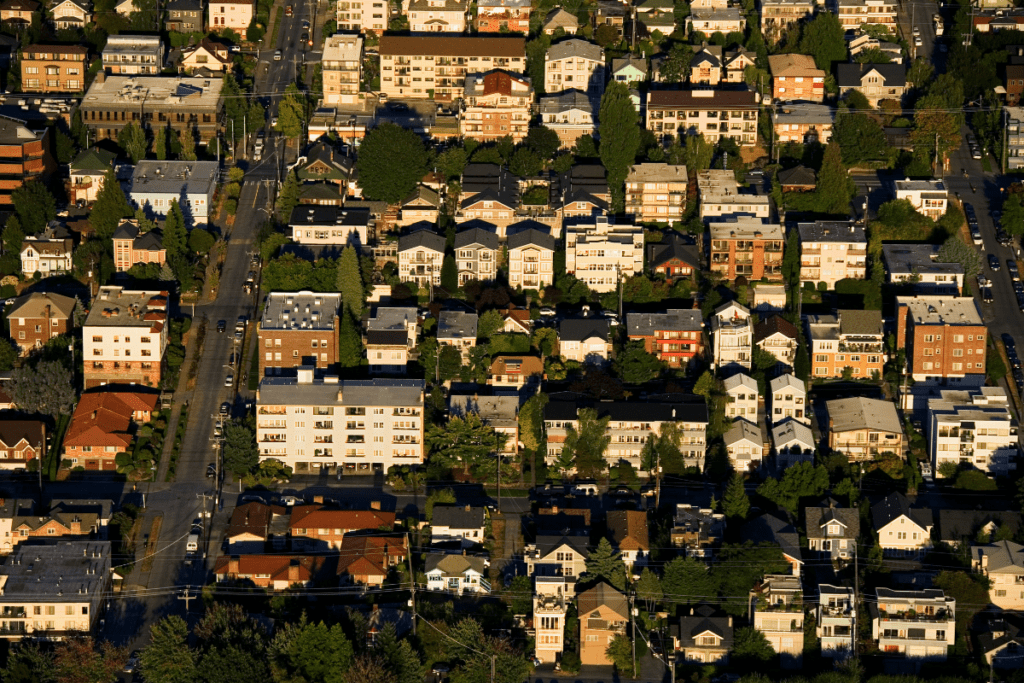
Rajiv and Cliff here with your latest building performance standards (BPS) updates. There’s nothing we love more than a new player on the BPS roster. This time coming straight out of the ethereal mountain landscape of Seattle—birthplace of grunge and Sir Mix-A-Lot.
On December 12th, 2023, the City Council of Seattle unanimously passed a Building Emissions Performance Standard (BEPS). The following day, Mayor Harrell signed it into law. Seattle is now the 13th jurisdiction in the U.S. with a building performance standard (BPS) on the books. Check out our breakdown of their process, passage, and next steps. We interviewed two City of Seattle employees: Nicole Ballinger, Building Emissions Performance Standard Program Manager, and Jessyn Farrell, Director, Office of Sustainability and Environment (OSE), to learn more.

Why did Seattle pursue a BPS?
Nicole Ballinger: While Seattle’s Building Emissions Performance Standard or “BEPS” is certainly building on the influence of other leading cities that are calling for BPS that you have worked with at IMT, such as New York, Boston, and others. BPS were called for in our 2018 Climate Action Strategy. That was following up on Energy Benchmarking and Building Tune-Ups, recognizing that while those policies were impactful, they weren’t getting us the emissions reductions we needed to meet our 2013 Climate Action Plan goals, which call for nearly 40% emissions reduction by 2030 and net-zero by 2050. As part of Mayor Harrell’s leadership and commitment to tackling the climate crisis—he directed the city to engage stakeholders across all sectors—to inform and develop an equitable policy.
Jessyn Farrell: When you do complex policy, it’s that confluence of: the political leadership that wants to do it; the advocacy community having all the tools at their disposal and being engaged; and the city, bureaucracy, office of sustainability and environment having done our homework over many years. When the politics aligned, we were able to have the policy ready to go.
How will this policy help Seattle meet its climate and equity goals?
Jessyn: This policy is a triple win in a lot of ways, because it results in one, decarbonization. Two, it can really improve a person’s experience of being inside a building. Seattle is part of the country where we have not historically had to have air conditioning. This BPS is a way to put in place cooling. It’s not just heat waves, it’s wildfire smoke where now people are having to stay inside, and it’s miserable when your space is hot and now smoky. And it only compounds all of the respiratory impacts that low-income and Black, Indigenous, People of Color (BIPOC) communities in particular experience in our city, and cities across the country. Being able to have clean and healthy spaces indoors is important because the burden of bad air quality is already falling on BIPOC members of our community.
Nicole: We were already seeing building owners, especially in the multifamily sector, looking at their ventilation systems and thinking about where they can initially put heat pumps into a community room where people can go during heat waves.
Jessyn: The third part of the equation is the workforce development and the fostering of really good paying jobs. But we really talk about those three pieces—meeting our goals, the adaptation, and then the economic benefits for folks.
Seattle’s BEPS Balances Flexibility and Complexity
The BEPS law covers large buildings over 20,000 sq. ft. and offers various compliance pathways to accommodate diverse building types and ownership structures.
- Standard Compliance: Requires buildings to meet specific greenhouse gas intensity (GHGI) targets at each five-year compliance interval. It also offers exemptions for all-electric buildings, recognizing the lower emissions profile of buildings that rely on electricity as their sole energy source.
- Modified Compliance: Extensions, emissions deductions for certain energy uses, alternative compliance payments, and extensions for certain buildings (e.g., high vacancy rates, affordable housing). This flexibility is crucial for buildings that might not feasibly meet the standard compliance requirements due to structural or operational constraints.
- Special Cases: For buildings with specific decarbonization challenges, this pathway allows for the development of tailored decarbonization compliance plans. These plans are designed to achieve net-zero or low emissions by the 2041-2050 timeframe, taking into account building-specific factors and paving the way for innovative, customized solutions to emissions reduction.
While the law’s flexibility is a strength, it also introduces complexity, particularly in understanding and planning for compliance. Stakeholders like BOMA Seattle and affordable housing providers recommend that to help owners navigate the law’s complexity, Seattle should provide comprehensive outreach and education. The range of compliance options will undoubtedly overwhelm some owners, particularly those with limited resources or expertise in building management and regulatory compliance. So, the effectiveness of these pathways will depend significantly on the city’s ability to deliver clear, accessible guidance and support to all building owners. As part of Seattle’s next steps, rulemaking will provide a key opportunity to reduce and explain this complexity.

How does this BPS complement other climate actions that are under Seattle’s Green New Deal?
Jessyn: This is a really important piece of our overall climate goals to decarbonize our building, transportation, and waste sectors. It works in concert with a whole suite of policies that we’re pushing forward.
Nicole: For example, the BEPS, in the big picture, aligns with recent updates to both Washington and Seattle’s energy code. Building owners are continuously looking at asset requirements. It’s important to have the targets in place now to drive the market action, as we aim towards the longer term goals. We’ve heard from service providers in the market that it’s important for them to know the targets. We have our single-family Clean Heat Program where we’re doing replacements for oil heat, converting them into electric heat pumps. We have some plans to look at expanding that program for folks who might want to change out gas for a heat pump. Also, we’re considering other types of pilots and programs for cooking and other actions. All of this work supports lower emissions over time.
Jessyn: Buildings represent more than a third of emissions in Seattle. This policy will result in an almost 27% reduction in the buildings sector. That’s a 10% overall emissions reduction—one of the most significant things that the city can do at this time.
Washington vs. Seattle
As BPS policies are readily adopted throughout the country, states and cities will need to ensure their policies are in alignment to avoid confusion. Here’s where the Pacific Northwest policies match and differ:
| Seattle’s Building Emissions Performance Standards (CB 120718) | Washington State’s Clean Buildings Performance Standards (HB 1257) | |
|---|---|---|
| Year Enacted | 2023 | 2019 |
| First Performance Year | 2031-2035, depending on building size | 2026-2028, depending on building size |
| Covered Buildings | Commercial and multifamily 20,000 sq. ft. and larger | Commercial and multifamily 20,000 sq. ft. and larger |
| Performance Metric | Greenhouse gas emissions intensity targets (GHGIT) | Site energy use intensity (EUI) |
| Target Setting | Date-Certain Fixed Targets | Periodic Updates |
Seattle’s BPS uses fixed targets on fixed dates, similar to New York City, Boston, and Vancouver. Washington State’s BPS is updated at periodic intervals, with fixed EUI targets set for 2026-2028, based on improvements in the building stock and changes to the ASHRAE 100 standard.
Laying the Groundwork: Seattle’s Approach to Policy Implementation
The city is setting itself up for rulemaking by engaging a wide range of stakeholders, from building owners to community based organizations to environmental experts, ensuring diverse perspectives shape the policy’s implementation. This process is critical for creating realistic and effective regulations that align with the city’s broader climate and equity goals. The focus on phased implementation and regular revisions based on stakeholder feedback exemplifies a commitment to continuous improvement and adaptability in policy application, providing an excellent example for localities around the country.
Seattle will help direct owners of covered buildings to financial support to augment other sources and help building owners reduce emissions. Here’s a breakdown:
- Grants and subsidies will reduce the financial burden on building owners undertaking decarbonization projects. One example is Washington state’s Building Electrification Program.
- Low-interest loans through existing programs like Commercial Property Assessed Clean Energy + Resiliency (C-PACER) and Washington’s Housing Finance Commission Loan program are available to improve nonprofits, commercial, industrial, mixed-used, and multifamily properties.
- Tax incentives, such as the federal Section 179D Commercial Buildings Energy-Efficiency Tax Deduction, will defray costs for building owners who make energy-efficient improvements.
- Rebates and incentives from utility companies Seattle City Light and Puget Sound Energy will assist with upgrades, incentivizing building owners to improve energy efficiency.
- Seattle-specific funding will support in-depth engineering design and provide capital for affordable housing, non-profit owned buildings, and buildings serving frontline communities. The city has included $4.5 million in the 2024 budget to support these efforts through its Seattle Clean Buildings Accelerator—a program that also provides free coaching, support, and training for owners and managers or operators of commercial and multifamily buildings to meet energy efficiency requirements and to reduce climate-polluting emissions.
As Seattle defines its own city-specific incentives, it is important to learn from critiques the state’s incentives have faced. As it stands now, the qualifications for Washington state’s Early Adopter Incentive Program are stringent, limiting accessibility to buildings over 50,000 square feet with specific energy service providers and significantly higher energy use than targets allow. Moreover, the process’s complexity could dissuade potential applicants, the financial assistance may not suffice to cover extensive retrofitting costs, and the focus seems to tilt towards commercial entities, sidelining residential and heritage buildings under 50,000 square feet. To ensure a fair and effective decarbonization, Seattle can address issues of accessibility, complexity, adequacy, and equitable focus with their own incentive planning.
When it comes to budget and staffing, the Seattle BEPS budgets for 2023 and 2024 showcase a strategic approach to resource allocation.
- In 2023, $828,228 was designated for BEPS implementation, including hiring three full-time employees (FTEs) for compliance outreach, program data analytics, and IT development. There’s also funding for temporary research support, consultants for the Seattle Clean Buildings Accelerator, and inclusive stakeholder engagement.
- Pursuant to its 2023 budget, Seattle hired a Climate & Buildings Support Programs Advisor to strengthen the existing Seattle Clean Buildings Accelerator program.
- In 2024, to bolster BEPS compliance and support, Seattle plans to add three more FTEs. One FTE will provide technical support and building engineering expertise. The other two FTEs, aimed at enhancing enforcement and help desk capabilities, will support Seattle’s third-party technical assistance provider.
These moves are part of a broader strategy to ensure effective implementation and compliance with the BEPS. Seattle’s comprehensive budgeting for BEPS can serve as a template for other governments, illustrating the importance of dedicated staffing, diverse services, and targeted financial support for under-resourced buildings.

What has been your process around collaborating with local communities, building owners, and climate justice organizations?
Jessyn: The OSE team has created an engagement process that is based on listening. I’ve been an advocate, elected official, a bureaucrat and a lot of times, the government can create an engagement process that is literally just checking the box. “We had a meeting in a downtown building, five people came, we did it.”
Nicole: Over two years, we had more than 125 meetings, 4 webinars with more than 200 people at each of them. We really leveraged the stakeholder list that we had already from a decade of benchmarking and tune-ups implementation. We are working with folks on our climate justice team and reaching people through the Green New Deal Oversight Board and other local groups, to make sure that we are being expansive beyond just the building owners that are being impacted. We worked closely with our affordable housing community in particular, and labor as well. Owners were looking for flexible pathways. Advocates want to make sure owners take this seriously. BEPS has strong penalties, but also many options and opportunities for owners to show that they’re making a concerted effort to reduce emissions. We will be building a robust support system with the goal of only a small contingent that might get to the penalty process.
What’s Next: Rulemaking
The success of Seattle’s BEPS law will depend not only on the specifics of the ordinance but also on effective rulemaking, inclusive implementation, and the active role of oversight bodies like Seattle’s Green New Deal Oversight Board (GNDOB). Created by ordinance in 2019 and comprising diverse representatives from frontline communities, tribes, labor, and environmental justice organizations, the GNDOB plays a crucial role in guiding the city’s budget priorities and initiatives under Seattle’s Green New Deal initiative.
The GNDOB can help bridge the gap between BEPS adoption and its successful implementation, by translating the ambitious goals of the BEPS law into actionable strategies that address the unique challenges and opportunities within Seattle’s built environment, particularly those from communities most impacted by environmental injustices.
In this context, the rulemaking process should and appears on track to embody clarity, adaptability and accessibility:
- Demystify GHG Calculations: Imagine every building in Seattle as a car, each emitting a different amount of greenhouse gasses based on how it’s used and powered. The city aims to create a simple “mileage chart” for these buildings, making it clear how much emissions are too much, helping building owners know if they’re on the right track or need to improve.
- Level the Playing Field: Not all buildings start from the same place; some are more densely occupied, some (like labs) house unusual activities, some operate 24/7. Seattle’s BPS allows for emissions deductions for certain activities like cooking and process loads, as well as “adjustment factors” for densely occupied buildings or hours of operation. These adjustments act like handicap scores in golf, giving each building a fair shot at meeting its emissions targets.
- Update the Rulebook: Like updating a software app for better performance, Seattle has the authority to refresh its list of building activities and their emissions targets for its second and final compliance intervals (after 2036). Doing so will help the rules keep pace with how buildings are used today, from co-working spaces to high-tech labs.
- Simplify Paperwork: Navigating government paperwork can be daunting. The city aims to streamline the process for building owners to apply for special considerations, easing the path for those with legitimate challenges, like historic buildings and affordable housing.
- Make Reporting User-Friendly: Building on the reporting structure for its 2012 benchmarking ordinance, Seattle will require that building owners comply with BEPS via Energy Star Portfolio Manager, the tool owners already use to benchmark their buildings. This continuity will simplify the process, significantly reducing building owners’ learning curve and effort required to report.
If Seattle succeeds, the BEPS ordinance will create a pathway to a climate-pollution-free city for the benefit of all.

Walk us through the process and plan for how the Office of Sustainability and Environment is going to conduct rulemaking?
Nicole: In Seattle, rulemaking is required by our administrative code and we expect it will take 12-18 months. The process is designed to clarify additional details that are required for owners to comply. For example, we will be detailing the documentation that building owners need to provide if they want to get an exemption or extension. Or if they want to use an alternative compliance path, like our decarbonization compliance plan, which is similar to the building improvement plan process that IMT has in your model law. We want to come forward with a framework and some concepts so we can get through the rules as soon as possible, so that people have the details they need to comply. We’re expecting to kick off the process by mid-2024, announcing details later this winter for how it will work. It’s not as open-ended as a legislative process where you’re waiting to get to the point where you can feel like everybody’s comfortable with it and pass it. We have the framework, now we have the mandate to decorate the house.
Seattle’s recent passage of the Building Emissions Performance Standard (BEPS) marks a major milestone in the city’s commitment to addressing climate change and promoting equity. Their approach to policy implementation, marked by inclusive engagement with various stakeholders and financial support through grants, loans, tax incentives, and rebates, positions it as a model for other cities striving for sustainability. IMT has advised OSE, building owners, advocates, and other stakeholders for over ten years including helping with development of Seattle’s benchmarking law. We welcome the opportunity to work with jurisdictions, communities, businesses, and other stakeholders around the country to develop win-win policies and programs to improve the built environment.


